Manaqish or manakish are savory pastries popular in the Levant (Eastern Mediterranean) region. My mother in law, a master of the Levant kitchen, was the one who first introduced me to the making of za’atar manaqish. They are the perfect make-ahead snack, appetizer, or even brunch!
What exactly are manaqish?
Manaqish are almost the Middle Eastern equivalent of homemade flatbread pizzas or Greek Ladenia. The word Manaqish is rooted in the Arabic verb naqash, which literally means to sculpt, or carve out. After the dough has been rolled flat, it is pressed by the fingertips to sculpt little dips for the topping to sit in.
Traditionally, manaqish like we have here are made from smaller portions of dough left over from daily baking. Classic manaqish are typically with one of three toppings: minced lamb, cheese, or a mixture of za’atar spice and olive oil.
How to serve Za’atar manaqish
Vegan za’atar manaqish are the most popular in many parts of the Levant. They are often served warm as breakfast with homemade labneh or feta cheese, which compliment the earthy bitterness of za’atar spice. Olives and fresh garden vegetables–tomatoes, cucumbers, and radish– are usually a part of the meal.
(Remember, sugar-laden breakfast cereals are a North American industrial presumption. In many parts of the world, breakfast is a warm, savory meal.)
But if having these for breafast or brunch isn’t something you would entertain, Za’atar manaqish also make a convenient afternoon snack. I often serve them mezze next to little plates like hummus and tabouli.
This recipe makes eight manaqish that are about 5 inches in diameter, so they are filling for a meal. But if you plan to serve them as an appetizer, you can make 12 or so smaller manaqish with the same recipe.
Print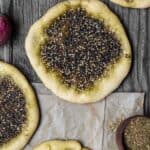
Za’atar Manaqish Recipe
- Total Time: 2 hrs and 38 mins
- Yield: serves 8
Description
Ingredients
For Dough
- 1 cup lukewarm water
- 1/2 tsp sugar
- 2 1/4 tsp active dry yeast (one package active dry yeast)
- 3 cups unbleached all-purpose flour, more for dusting
- 1 tsp salt
- 2 tbsp Private Reserve extra virgin olive oil
For Za’atar Topping
- 7 to 8 tbsp quality Za’atar spice
- 1/2 cup Private Reserve extra virgin olive oil
Serve with
- Fresh garden vegetables (tomato, cucumbers, radish)
- Olives
- Homemade labneh or feta cheese (omit if vegan)
Instructions
- In a small bowl, combine water, sugar and yeast. Set aside for 10 minutes to foam.
- Make the dough. In a large mixing bowl, combine flour, salt, and olive oil. Work the mixture with your hands. Now, make a well in the middle and pour in the yeast and water mixture. Stir until soft dough forms.
- Turn dough onto a lightly floured surface and knead for 10 minutes or until dough is elastic, smooth, and no longer sticky (as you knead, if dough is too sticky for you, you can sprinkle just a tiny bit of flour to help it).
- Form dough into a ball and place in a lightly oiled mixing bowl. Cover with damp cloth and place in a warm spot (inside a warmed but turned-off oven is a good place). Leave to rise for 1 hour and 30 minutes.
- Punch dough down. Knead briefly and form into 8 small balls. Arrange on lightly floured surface, cover again and leave to rise another 30 minutes.
- Prepare the za’atar topping. While dough is rising, mix together the za’atar spice and olive oil in a bowl.
- Preheat the oven to 400 degrees F. Place a large baking sheet in oven while heating.
- Form za’atar manaqish. Lightly oil the heated baking sheet and set near you. Flatten the dough into small discs about 5 inches in diameter. With your finger tips, make indentations in discs and add about 1 tbsp za’atar topping in the middle of each disc, leave a narrow boarder around. Arrange discs in prepared oiled baking sheet (use two sheets if needed, do not crowd the manaqish).
- Bake in 400 degrees F heated-oven for 7 to 8 minutes or until the dough is slightly browned on bottom and edges (za’atar topping will remain liquidy at this point). Remove from heat and let sit for 5 minutes or so, the topping will dry and settle into dough.
- Serve za’atar manaqish warm or at room temprature with assorted vegetables, olives, feta cheese, or homemade labneh.
Notes
- To serve as mezze simply portion the dough into smaller balls, form smaller discs about 3 inches in diameter instead. You should be able to make 12 or more manaqish. When you bake them, watch the oven closely as they will bake quicker.
- Make-ahead instructions You can make these a week or two ahead and simply freeze them in freezer bags (I like to double the freezer bags to prevent freezer burns). Take as many of the manaqish as you need out to thaw at room temperature or in the fridge overnight. Warm in low-temperature oven. If you don’t remember to take them out in advance, you can always simply heat in the oven from frozen.
- Recommended for this recipe our Greek Private Reserve extra virgin olive oil (from organically grown and processed Koreneiki olives) and our all-natural za’atar spice blend. We highly recommend the 3-pack za’atar spice bundle.
- SAVE! Try our Mediterranean Ultimate Spice Bundle! Or create your own 6-pack of all-natural or organic spices. Visit our store to browse our spices, olive oils and bundles!
- Prep Time: 2.5 hours
- Cook Time: 8 mins
- Category: Appetizer
- Method: Baked
- Cuisine: Mediterranean
Try these delicious recipes:
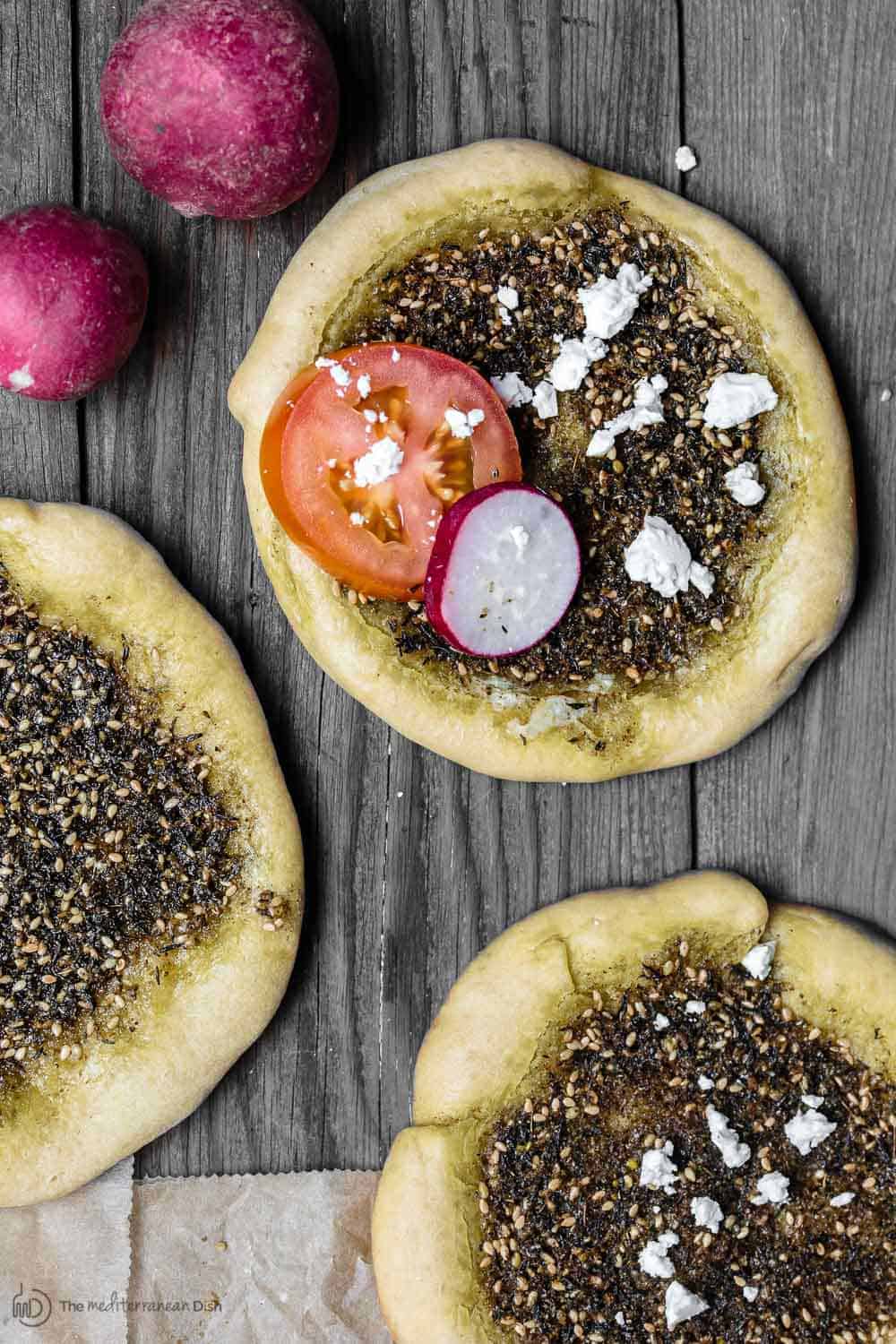
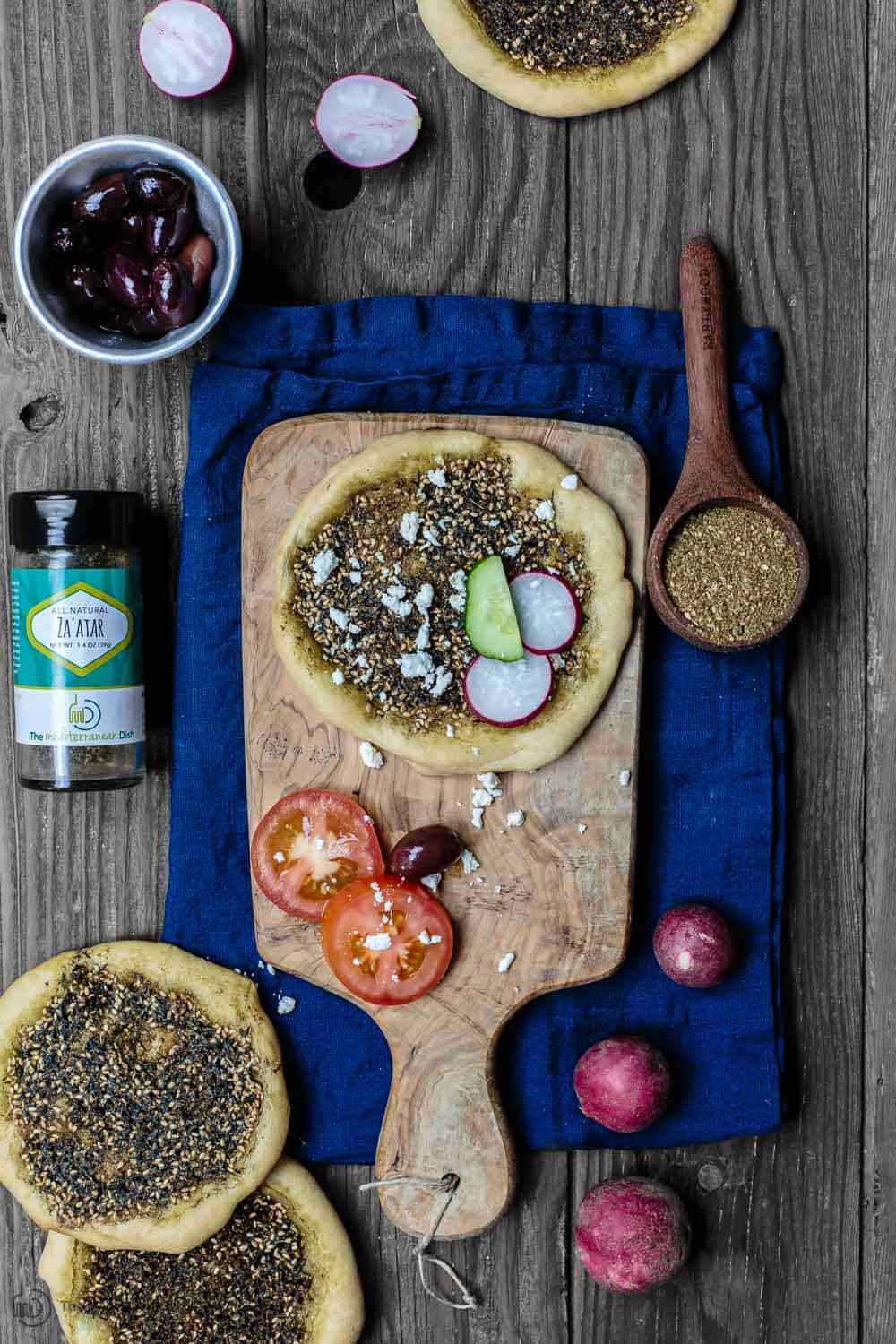
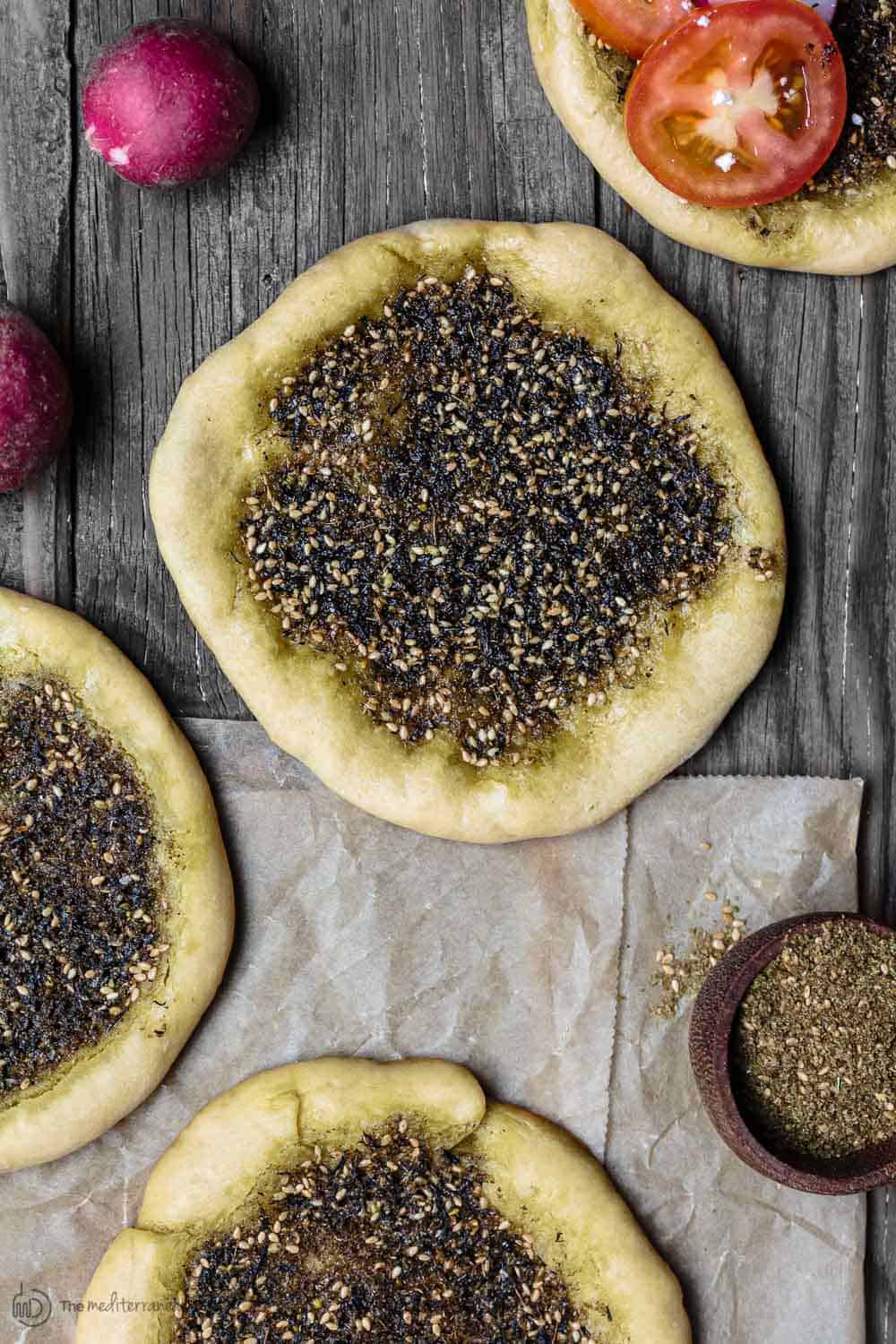
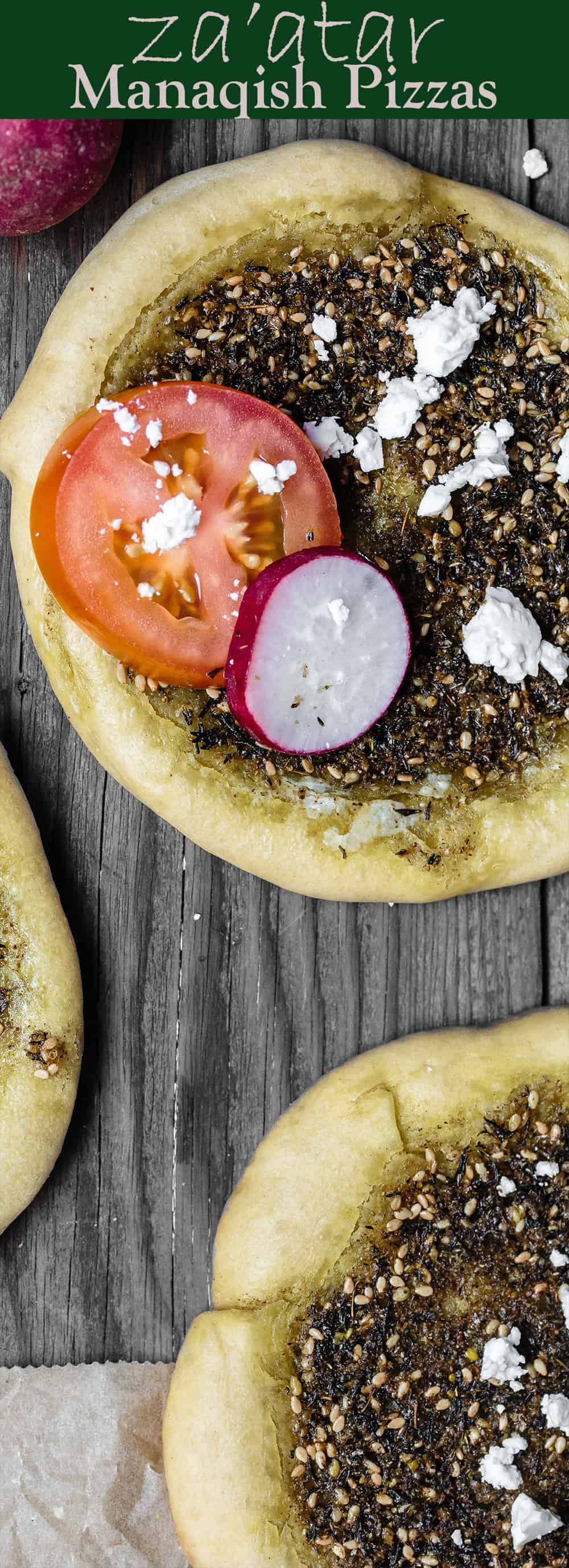
Im Lebanese-Egyptian born in Montréal Canada. I still prepare middle eastern dishes from time to time. I find your recipes flavourful.
Can you use Honey instead of sugar
Hi, Diane. Sure! That should work!
Thank you for all your awesomely delicious recipes. I bought your cookbook and then found your website! SO not sure if they turned out how they are supposed to taste or not as I have never had manaqish! However, they were delicious. I had left over pita dough from the Easy Pita Bread recipe so I repurposed it! They turned out really crunchy 🙂
Thanks, Suzy, for another good recipe, but I found a few tweaks necessary. For the za’atar mixture, I added 1/4 C minced yellow onion, 2 tsp. lemon juice, 1 1/2 T sumac and 2 tsp dibs ruman (pomegranate molasses) in order to make the flavor profile more complex. As other commenters noted, the manaqish were not baked through at the 7-minute mark; I left them in for 17 minutes before they turned golden. For the second batch, I raised the oven temperature to 450F and they were done at 9 minutes, but the dough was denser. Very tasty in any case!
Thanks for the feedback, Claudia!
Greetings,
I made manaqish today and followed your recipe by doubling it. They turned out to be Out of This World!
I grew up in the Middle East, and this recipe helped me reminisce about my childhood school days when I would pack one manaqish for school. Thank you, Suzy.
So glad this recipe brought you some sweet memories! Thanks, Valentina!
Hi! I love your recipes and have made this one several times. Sometimes, however, this dough doesn’t work for me – the flour to water ratio is off (too much flour). The climate where I live is very dry and sometimes the volume measurements for bread don’t work properly. Any chance you have this recipe in grams/weight – specifically for the flour and water?
Thanks!
Hi, Sasha. Unfortunately we don’t have a metric conversion available for this recipe at this time. That is a conversion we haven’t worked out perfectly for all of our recipes quite yet.
I used my bread machine on the Dough/Pasta Setting to make this and followed the recipe, only adding 1/4 teaspoon more sugar, by accident. It turned out incredible, this is the most delicious bread and perfect for comforting food. I had a side salad of cucumbers, parsley, tomatoes, lemon juice and olive oil with Sea Salt and feta and spooned some salad onto the Manakeesh. I was very proud of how wonderful a lunch I had made. Thank you Soo much and to your mum-in law.
Oh, I also had to add a whole 1 Cup of water after it started mixing and then a sprinkling of flour as I had put too much water, it is winter in the prairies with -40°C Temperatures and extremely dry, so it is expected to have to add much more water to any bread recipe am making!
Thank you for all of this feedback, Sara! Glad you loved the recipe!
Hi Suzy,
We tried making this, but at the first stage it did not seem like there was enough water to mix with the flour – it was VERY stringy and flaky and wouldn’t mix well. Tried adding some water but it ended up very dense and not elastic, though that’s likely on us as probably added too much.
A note – we tried making 1/2 recipe, so 1 and 1/2 cups of flour and 1/2 cup of water. Not sure if maybe this is why it didn’t work. Any tips?
Thanks
I love zaaatar bread and everything in the recipe was easy and perfect to make. The only problem I faced was that my bread became hard and crispy instead of soft as within 8 minutes my bread didn’t turn brown so I kept it little longer in the oven. Also please specify which rack of oven ( low, middle or top). Thanks
Hi, Ritu. I recommend the middle rack.
I had the same thing happen: the edges did not start to color after some 8 minutes in the oven so I left bread in a couple more. When I took it out it was HARD. I mean, quite hard. Even dipping it in a hearty bean/pork/veggie soup didn’t help. Not sure we can even use it though I put it in a plastic baggie to see. Very disappointed. Plus 10 minutes kneading was very, very difficult for arthritic hands.
Thank you so much for this wonderful recipe!
I’ve tried out various recipes in my search to recreate the za’atar manoushe that I remember from my childhood in Lebanon, and this is by far the best one I’ve come across! I’ll be coming back to it again and again 🙂
My, pleasure, Natascha. So glad you enjoyed it!
Hi Suzy,
Thank you for all the yummy recipes. I tried a couple and they all turned out great!
Concerning this recipe, do I have to use unbleached flour or can I use bleached instead?
I just use what is listed in the recipe, but you can try bleached flour if you like
I just love everything in this site!! Shukrannnm ❤️
Aww! Thank you, Cris!